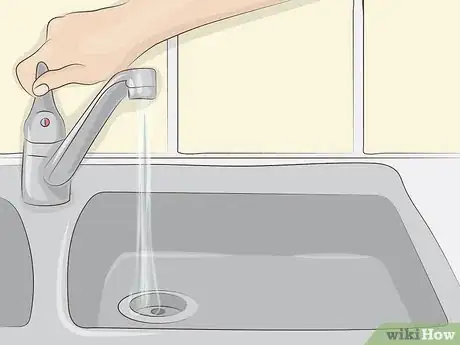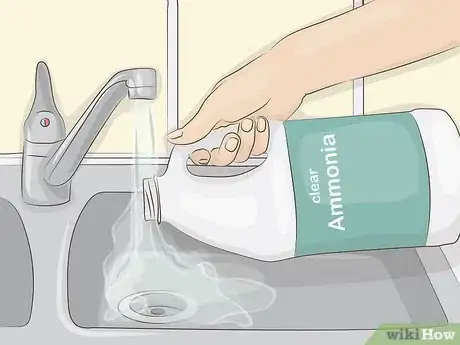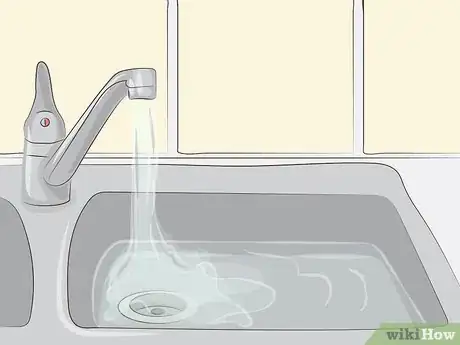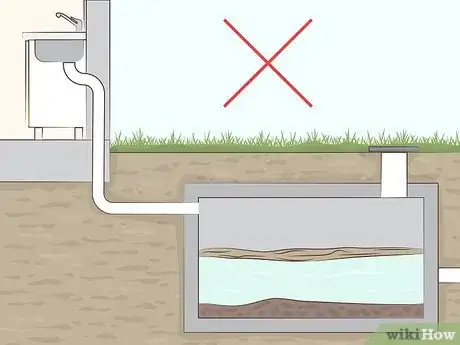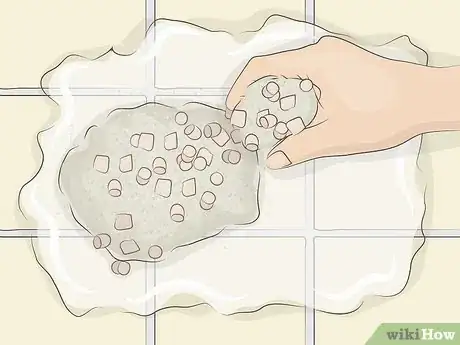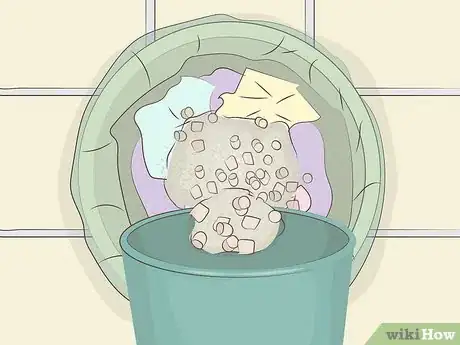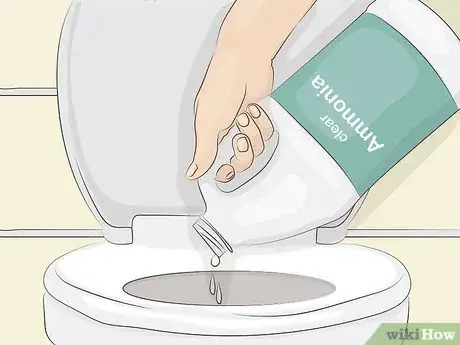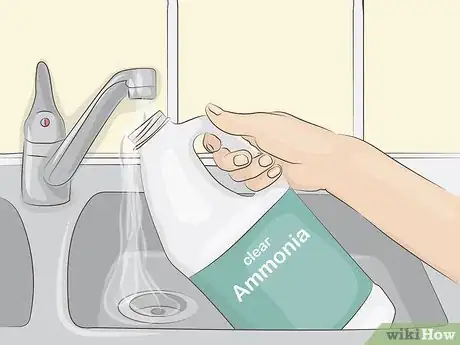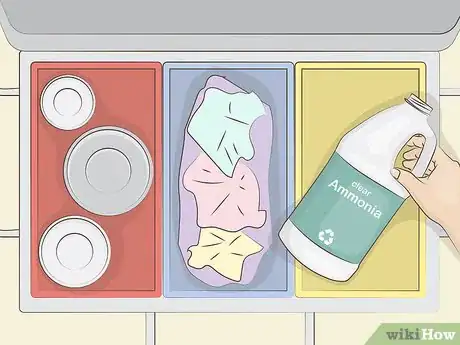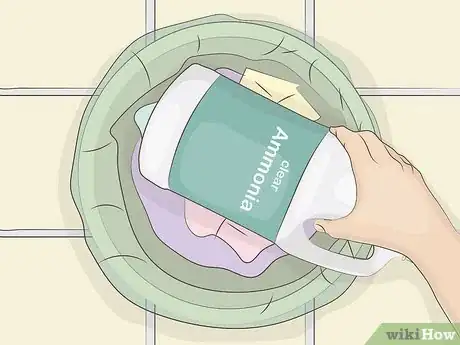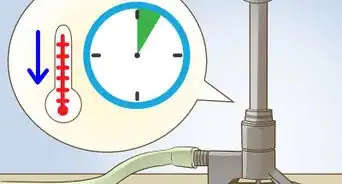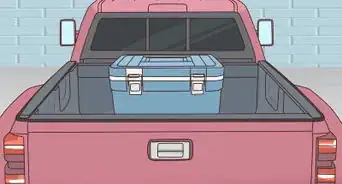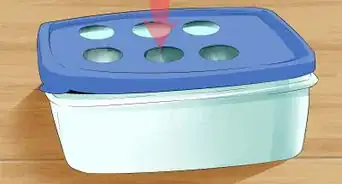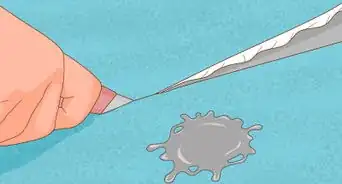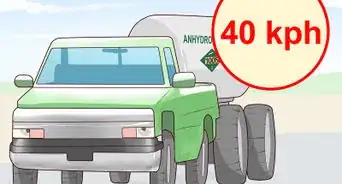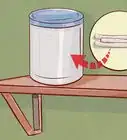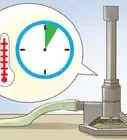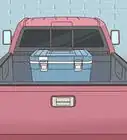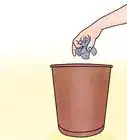This article was co-authored by wikiHow staff writer, Danielle Blinka, MA, MPA. Danielle Blinka is a Writer, Editor, Podcaster, Improv Performer, and Artist currently living in Houston, TX. She also has experience teaching English and writing to others. Danielle holds a Bachelor of Arts in English, Bachelor of Arts in Political Science, Master of Arts in English with a concentration in writing, and Master of Public Administration from Lamar University.
This article has been viewed 95,480 times.
Learn more...
Ammonia is a commonly used cleaning product. Although it’s a strong chemical, it's not considered a household hazardous waste. That means you can dispose of it in the sink, as long as you flush it with plenty of water. If you have a lot of ammonia or a septic system, you can neutralize the ammonia and throw it away. After you dispose of the ammonia, you’ll need to recycle or throw out the container.
Steps
Diluting Ammonia with Water
-
1Turn on a water faucet. You need to mix the ammonia with plenty of water, as it's concentrated. Water dilutes the ammonia, making it safer. The best way to do this is to use running water.[1]
- You can also flush ammonia down your toilet. Simply pour it into the toilet water before flushing. Make sure you don't pour in more ammonia than there is water, however. If you have a lot of ammonia, use the sink or neutralize it.[2]
-
2Pour the ammonia into the stream of water. Slowly pour out the ammonia so that there is more water than ammonia going down the sink. This ensures that it’s thoroughly diluted as it goes down the sink.[3]
- Don’t inhale the ammonia as you pour it.
- It’s best to open a window or turn on a vent while you pour the ammonia down the sink.
Advertisement -
3Rinse your sink after disposing the ammonia. Splash water over the surface of the sink to remove any ammonia residue that may remain. Wipe the sides and bottom of the sink with a clean towel or cloth to make sure the ammonia is gone. This ensures you won’t accidentally pour another chemical over it.[4]
- Make sure your sink runs at least 1 additional minute.
- If you have a spray nozzle, use it to rinse out the sink.
-
4Use caution if you have a septic system. It’s not a good idea to dispose of ammonia down the sink if you have a septic system.[5] Septic systems discharge wastewater back into the ground, so the ammonia can end up in the ground water. This is especially problematic if you use a well for your water.[6]
- Instead of pouring the ammonia down the sink, neutralize it and throw it away.
Neutralizing the Ammonia
-
1Mix together equal parts baking soda, cat litter, and dry sand. These 3 ingredients will create an effective dry mixture that will soak up the ammonia. You can use the mixture to clean up ammonia you’ve spilled or you can mix it with excess ammonia you want to discard.[7]
- The dry mixture is great for when you need to dispose a lot of ammonia at once.
-
2Sprinkle the dry mix over the ammonia. Continue to add dry mixture to the ammonia until you’ve applied enough dry mix to soak up all of the ammonia. You should not have any liquid remaining.[8]
-
3Collect the mixture into a disposable container. Use a plastic or wooden spoon to scoop the mixture into the container. If you fill up the container and still have more mixture to collect, it’s okay to dump it out in a trash bag. Then, collect the rest of the mixture.[9]
- Wear a mask while you clean up the mixture to avoid inhaling any fumes.
- It’s a good idea to ventilate the area, if it’s indoors. If you have a fume hood, you should turn it on.
-
4Dispose of the mixture in the trash. Since the ammonia is neutralized, it’s safe to put it in the trash can. You can throw out the entire container or simply dump out the mixture.[10]
- Don’t let the neutralized ammonia sit around your house, however. You need to dispose of it immediately.
Getting Rid of the Container
-
1Empty the container of excess ammonia. Don’t throw away a container that still has ammonia in it, even if it’s very little. Since ammonia is concentrated, it can be hazardous even in small amounts.[11]
- For example, the fumes from the ammonia can be harmful. Also, it could mix with other substances in the trash.
-
2Rinse out the container. Use clean water to wash away any ammonia that remains in the bottle. The water will also dilute any droplets that linger in the container.[12]
- It’s safe to pour your rinse water down the sink.
-
3Check the bottle to see if it’s recyclable. Most plastic cleaner bottles are recyclable. Simply check the bottom of the container to see if it has a symbol indicating you can recycle it.
- If it is recyclable, you can put it in with your other recyclables. Alternatively, you can take it to your local recycling center.
-
4Throw it in the trash if you can’t recycle it. Put it in with the rest of your trash. It’s best to throw it out in your outdoor trash can, if you can. That way you won’t have to worry about accidental fume emissions.
Community Q&A
-
QuestionWhat is the pH of ammonia and what is it in the household product one buys in the grocery store?
 Ahomes1Community AnswerOne molecule of ammonia consists of one negatively-charged nitrogen ion and three positively-charged hydrogen ions, giving ammonia a chemical formula of NH3. The pH of standard ammonia is about 11.
Ahomes1Community AnswerOne molecule of ammonia consists of one negatively-charged nitrogen ion and three positively-charged hydrogen ions, giving ammonia a chemical formula of NH3. The pH of standard ammonia is about 11. -
QuestionDoes vinegar break the molecular bonds of ammonia?
 GainKnowledgeCommunity AnswerVinegar will neutralize ammonia while getting rid of the smell. Since vinegar is inexpensive, many people use the versatile liquid to clean their homes from top to bottom. To remove the ammonia odour, blot or spray the area with pure, undiluted white vinegar.
GainKnowledgeCommunity AnswerVinegar will neutralize ammonia while getting rid of the smell. Since vinegar is inexpensive, many people use the versatile liquid to clean their homes from top to bottom. To remove the ammonia odour, blot or spray the area with pure, undiluted white vinegar.
Warnings
- Don’t combine ammonia with any other products, including other cleaners. Dispose of them one at a time, flushing them down the drain with plenty of water.⧼thumbs_response⧽
- Do not simply put excess ammonia in the trash. You must either dilute it or neutralize it.⧼thumbs_response⧽
- Ammonia and bleach create a dangerous gas when mixed, so be very careful not to mix the two during disposal.[13]⧼thumbs_response⧽
References
- ↑ https://www.mda.state.mn.us/disposal-options-anhydrous-ammonia
- ↑ https://erc.cals.wisc.edu/wp-content/blogs.dir/14/files/2017/04/G3455_Solvents-and-Home-Cleaning-Products.pdf
- ↑ https://www.wef.org/globalassets/assets-wef/3---resources/for-the-public/public-information/sustainability-household-waste-disposal-chart.pdf
- ↑ https://erc.cals.wisc.edu/wp-content/blogs.dir/14/files/2017/04/G3455_Solvents-and-Home-Cleaning-Products.pdf
- ↑ https://www.wef.org/globalassets/assets-wef/3---resources/for-the-public/public-information/sustainability-household-waste-disposal-chart.pdf
- ↑ https://erc.cals.wisc.edu/wp-content/blogs.dir/14/files/2017/04/G3455_Solvents-and-Home-Cleaning-Products.pdf
- ↑ https://books.google.com/books?id=bLV55kunjA4C&pg=PA35&lpg=PA35&dq=sodium+bicarbonate+cat+litter+ammonia&source=bl&ots=LqbPhju0bc&sig=yeQ_4dyoxrt0pcTdbvv6c6cBEJA&hl=en&sa=X&ved=0ahUKEwiPi4Xa2N7KAhXI7SYKHQ2WCYQQ6AEIRTAG#v=onepage&q=sodium%20bicarbonate%20cat%20litter%20ammonia&f=false
- ↑ https://books.google.com/books?id=bLV55kunjA4C&pg=PA35&lpg=PA35&dq=sodium+bicarbonate+cat+litter+ammonia&source=bl&ots=LqbPhju0bc&sig=yeQ_4dyoxrt0pcTdbvv6c6cBEJA&hl=en&sa=X&ved=0ahUKEwiPi4Xa2N7KAhXI7SYKHQ2WCYQQ6AEIRTAG#v=onepage&q=sodium%20bicarbonate%20cat%20litter%20ammonia&f=false
- ↑ https://books.google.com/books?id=bLV55kunjA4C&pg=PA35&lpg=PA35&dq=sodium+bicarbonate+cat+litter+ammonia&source=bl&ots=LqbPhju0bc&sig=yeQ_4dyoxrt0pcTdbvv6c6cBEJA&hl=en&sa=X&ved=0ahUKEwiPi4Xa2N7KAhXI7SYKHQ2WCYQQ6AEIRTAG#v=onepage&q=sodium%20bicarbonate%20cat%20litter%20ammonia&f=false
- ↑ https://books.google.com/books?id=bLV55kunjA4C&pg=PA35&lpg=PA35&dq=sodium+bicarbonate+cat+litter+ammonia&source=bl&ots=LqbPhju0bc&sig=yeQ_4dyoxrt0pcTdbvv6c6cBEJA&hl=en&sa=X&ved=0ahUKEwiPi4Xa2N7KAhXI7SYKHQ2WCYQQ6AEIRTAG#v=onepage&q=sodium%20bicarbonate%20cat%20litter%20ammonia&f=false
- ↑ https://erc.cals.wisc.edu/wp-content/blogs.dir/14/files/2017/04/G3455_Solvents-and-Home-Cleaning-Products.pdf
- ↑ https://www.mda.state.mn.us/disposal-options-anhydrous-ammonia
- ↑ https://erc.cals.wisc.edu/wp-content/blogs.dir/14/files/2017/04/G3455_Solvents-and-Home-Cleaning-Products.pdf
About This Article
While ammonia is a strong chemical, it’s not considered a household hazardous waste and can be disposed of easily down your sink. You’ll want to dilute your ammonia to make it safer to dispose of, so turn on the water faucet and pour it into the stream of water so there’s more water than ammonia going down the drain at any given time. Once you’re done, rinse your sink out with clean water. You can also flush ammonia down your toilet as long as you don’t pour more ammonia in than there is water. If you need to throw the ammonia away, mix together equal parts baking soda, cat litter, and dry sand to soak up the ammonia. Then, add the dry mixture to the ammonia until there’s no liquid remaining. Pour the mixture into a disposable container and put it in the trash. To learn how to get rid of an ammonia container, keep reading!
